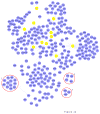Cellular networks involved in the influenza virus life cycle
- PMID: 20542247
- PMCID: PMC3167038
- DOI: 10.1016/j.chom.2010.05.008
Cellular networks involved in the influenza virus life cycle
Abstract
Influenza viruses cause epidemics and pandemics. Like all viruses, influenza viruses rely on the host cellular machinery to support their life cycle. Accordingly, identification of the host functions co-opted for viral replication is of interest to understand the mechanisms of the virus life cycle and to find new targets for the development of antiviral compounds. Among the various approaches used to explore host factor involvement in the influenza virus replication cycle, perhaps the most powerful is RNAi-based genome-wide screening, which has shed new light on the search for host factors involved in virus replication. In this review, we examine the cellular genes identified to date as important for influenza virus replication in genome-wide screens, assess pathways that were repeatedly identified in these studies, and discuss how these pathways might be involved in the individual steps of influenza virus replication, ultimately leading to a comprehensive understanding of the virus life cycle.
Copyright (c) 2010 Elsevier Inc. All rights reserved.
Figures




References
-
- Barman S, Ali A, Hui EK, Adhikary L, Nayak DP. Transport of viral proteins to the apical membranes and interaction of matrix protein with glycoproteins in the assembly of influenza viruses. Virus Res. 2001;77:61–69. - PubMed
Publication types
MeSH terms
Grants and funding
LinkOut - more resources
Full Text Sources
Other Literature Sources

